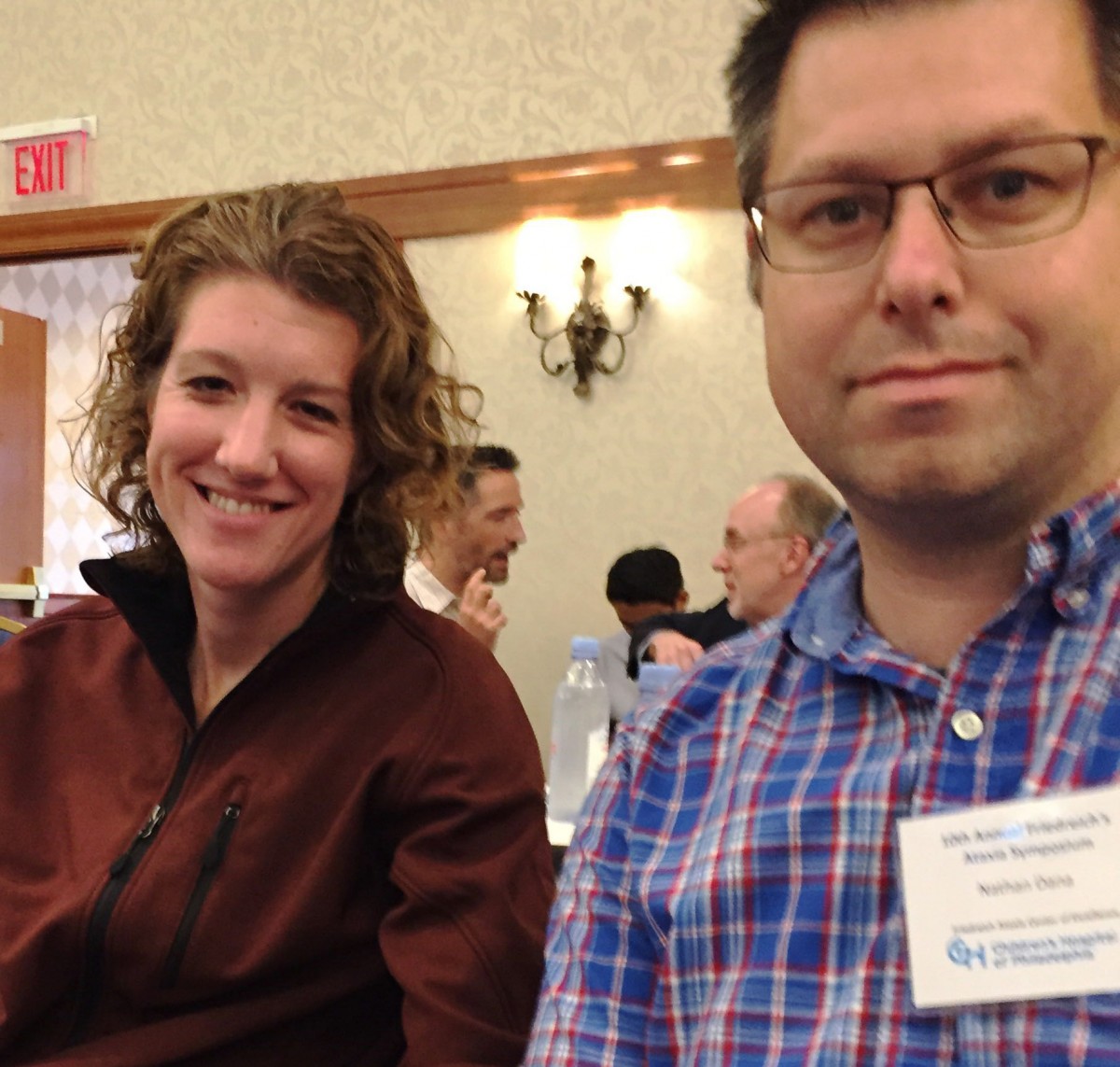HOW CAN WE HELP YOU? Call 1-800-TRY-CHOP
In This Section
Friedreich's Ataxia Community Stays on Top of Science and Stays in Touch
 Patients and families dealing with the rare, debilitating disease Friedreich’s Ataxia showed their true strength at the 10th Annual Friedreich’s Ataxia Symposium held in King of Prussia, Pa. The FA community is a steadfast supporter of research, and they have been gathering for a decade to spend a day with each other building friendships and learning the most up-to-date information on the therapeutic approaches and scientific studies being conducted in the field of FA.
Patients and families dealing with the rare, debilitating disease Friedreich’s Ataxia showed their true strength at the 10th Annual Friedreich’s Ataxia Symposium held in King of Prussia, Pa. The FA community is a steadfast supporter of research, and they have been gathering for a decade to spend a day with each other building friendships and learning the most up-to-date information on the therapeutic approaches and scientific studies being conducted in the field of FA.
Researchers from Children’s Hospital of Philadelphia took a moment during each of their presentations to sincerely thank the attendees: “We could not make these discoveries without you.”
FA is a progressive neuromuscular disease that occurs in approximately one in 50,000 people in the U.S. It’s caused by inherited deficiencies in the mitochondrial protein called frataxin that lead to an energy gap in cells. Our brains and hearts use a huge chunk of the energy that our bodies produce, so when people with FA’s mitochondria aren’t working to full capacity, they usually experience neurologic dysfunction that affects the flow of sensory information, and their heart muscle doesn’t pump blood efficiently. People with FA have trouble with balance, coordination, and fatigue, but the disease does not affect the part of the brain involved in cognition and learning.

Holly Hedrick, MD, a surgeon in the division of Pediatric General, Thoracic and Fetal Surgery at CHOP, has a 16-year-old daughter, Grace, who has FA and is cared for by David Lynch, MD, PhD, a CHOP pediatric neurologist and co-director of the Friedreich's Ataxia Center of Excellence.
Patrick Ritschel took part in the symposium Oct. 16 because he has two daughters who have FA, Samantha, 13, and Angelina, 15. They both are patients and research participants at CHOP under the care of David Lynch, MD, PhD, a pediatric neurologist who is director of the Friedreich’s Ataxia Program, and Kimberly Lin, MD, in cardiology. Samantha and Angelina have been included in a number of non-interventional trials at CHOP and are enrolled in a natural history study of FA, which in October received $2 million in grant support from the U.S. Food and Drug Administration (FDA).
The natural history study is helping Dr. Lynch and colleagues characterize and understand how the FA disease process evolves during individuals’ lifetimes and how to measure reasonable improvement in the condition. Currently, no drug therapy is available to halt or delay disease progression or reduce FA symptoms.
This year was the fifth time Ritschel has traveled from Wilmington, Del., to attend the event, which was hosted by the Penn Medicine/CHOP Friedreich’s Ataxia Center of Excellence. Dr. Lynch co-directs the Center along with Robert Wilson, MD, PhD, a senior scientist in the Center for Mitochondrial and Epigenomic Medicine.
“There is a great sense of community and interconnectedness among the folks who are here,” Ritschel said. “The Center of Excellence and the people at CHOP have the ability to integrate the basic research with the clinical piece, which is really powerful. Their knowledge and capability are second to none.”
The Center launched in 2014 with a $3.25 million gift from FARA, the Friedreich’s Ataxia Research Alliance, in partnership with the Hamilton and Finneran families to focus on expanding research on the cardiology of FA, pursuing new basic research avenues, facilitating drug discovery, and establishing a biomarker development program with the expertise of Ian Blair, PhD, A.N. Richards Professor, vice chair of Penn’s department of Systems Pharmacology and Translational Therapeutics, and director of Penn’s SRP Center.
“The Center is incredibly valuable,” Dr. Wilson said. “We bat around ideas. We debate. Having all that expertise in one place creates incredible synergy. It is not just a concentration of intellect, but a stability of funding that helps us keep the best people and allows us to do much more complex and difficult investigations.”
Several of the Center’s researchers, including Dr. Wilson, Dr. Lynch, Dr. Blair, Dr. Lin, and Shana McCormick, MD, MTR, an attending physician in the division of Endocrinology and Diabetes at CHOP, also gave updates on some of the studies that they’re working on. They demonstrated how being involved with the Center motivates them to continually “push the envelope” to look at new mechanisms that may be underlying FA and to find reliable biomarkers to monitor the effects of investigational therapies.
For example, Dr. Blair has been using mass spectrometry methodology to examine and measure molecular abnormalities in platelets isolated from FA. Part of this work suggests that apolipoprotein A1 (ApoA-1) levels are low in FA. ApoA-1 is a major protein constituent of high-density lipoprotein, or HDL, cholesterol. Dr. Blair’s laboratory team developed a mass spectrometry-based assay as an accurate quantification method that would allow for ApoA-1 to be used as a potential FA diagnostic biomarker. Their findings may point toward future research directions aimed at optimizing HDL-cholesterol levels in patients with FA as a therapeutic option. He also described a new way of accurately quantifying frataxin (the protein that is reduced in FA) in whole blood so that new therapies can be properly evaluated.
During her presentation, Jennifer Farmer, executive director of FARA, shared some highlights from the nonprofit organization’s efforts to align scientists, patients, clinicians, government agencies, and pharmaceutical companies in their quest to find a cure for FA. In June, FARA and several other patient advocacy groups dedicated to FA and related diseases for the first time participated in a FA patient focused drug development meeting, and they subsequently published a report called “Voice of the Patient”.
This opportunity allowed patients living with FA to tell the FDA and drug developers in their own words about their experiences with FA, what matters to them most about their quality of life, their view of potential therapies’ benefits and risks, and where they would like to see research move forward. One of the report’s conclusions is that while the majority of patients noted that balance, dexterity, and fatigue affected their lives the most now, their greatest concern for the future is the development and progression of cardiomyopathy because it is life-shortening.
 Symposium attendees came from all over the country, including Allison Dana, a FARA ambassador from North Carolina who spent the day with her husband, Nathan (right), and her black and white Great Dane service dog, Zeppelin, at her side. While Allison Dana said hearing about the latest progress toward therapies is helpful, she found “the social aspect more immediate.” As an ambassador, she is a peer representative and spokesperson dedicated to building and upholding relationships within the FA community. At previous symposiums, Allison Dana has given presentations on daily living with FA such as managing a career and bringing a service dog into the household.
Symposium attendees came from all over the country, including Allison Dana, a FARA ambassador from North Carolina who spent the day with her husband, Nathan (right), and her black and white Great Dane service dog, Zeppelin, at her side. While Allison Dana said hearing about the latest progress toward therapies is helpful, she found “the social aspect more immediate.” As an ambassador, she is a peer representative and spokesperson dedicated to building and upholding relationships within the FA community. At previous symposiums, Allison Dana has given presentations on daily living with FA such as managing a career and bringing a service dog into the household.
Closer to home, Holly Hedrick, MD, a surgeon in the division of Pediatric General, Thoracic and Fetal Surgery at CHOP, has a 16-year-old daughter, Grace, who has FA and is cared for by Dr. Lynch and the FA team. They have been involved since the first symposium, when Grace was diagnosed at 5 years old, and the annual meeting helps to remind them that they are not alone in facing FA.
“It is amazing to see the power of the FA community coming together every year,” Dr. Hedrick said. “The day is so hopeful, and CHOP is the epicenter of care and research for FA.”